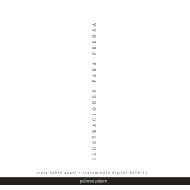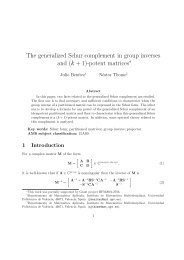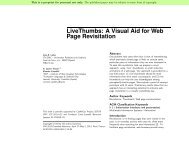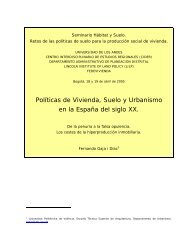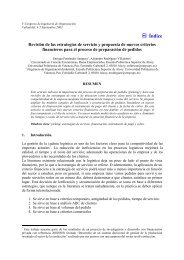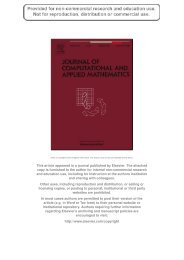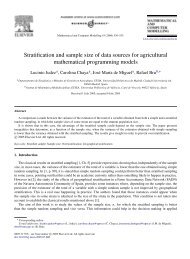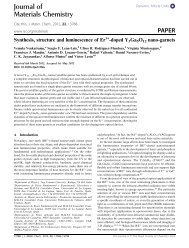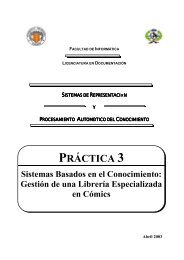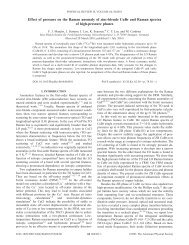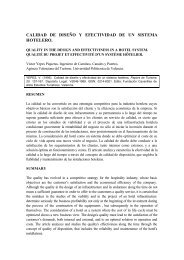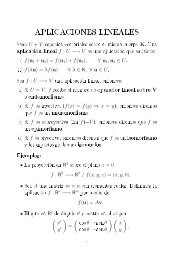Introduction to the resistivity surveying method. The resistivity of ...
Introduction to the resistivity surveying method. The resistivity of ...
Introduction to the resistivity surveying method. The resistivity of ...
You also want an ePaper? Increase the reach of your titles
YUMPU automatically turns print PDFs into web optimized ePapers that Google loves.
1<br />
1 <strong>Introduction</strong> <strong>to</strong> <strong>resistivity</strong> surveys<br />
1.1 <strong>Introduction</strong><br />
<strong>The</strong> purpose <strong>of</strong> electrical surveys is <strong>to</strong> determine <strong>the</strong> subsurface <strong>resistivity</strong> distribution<br />
by making measurements on <strong>the</strong> ground surface. From <strong>the</strong>se measurements, <strong>the</strong> true<br />
<strong>resistivity</strong> <strong>of</strong> <strong>the</strong> subsurface can be estimated. <strong>The</strong> ground <strong>resistivity</strong> is related <strong>to</strong> various<br />
geological parameters such as <strong>the</strong> mineral and fluid content, porosity and degree <strong>of</strong> water<br />
saturation in <strong>the</strong> rock. Electrical <strong>resistivity</strong> surveys have been used for many decades in<br />
hydrogeological, mining and geotechnical investigations. More recently, it has been used for<br />
environmental surveys.<br />
<strong>The</strong> <strong>resistivity</strong> measurements are normally made by injecting current in<strong>to</strong> <strong>the</strong> ground<br />
through two current electrodes (C1 and C2 in Figure 1), and measuring <strong>the</strong> resulting voltage<br />
difference at two potential electrodes (P1 and P2). From <strong>the</strong> current (I) and voltage (V)<br />
values, an apparent <strong>resistivity</strong> (p a ) value is calculated.<br />
p a = k V / I<br />
where k is <strong>the</strong> geometric fac<strong>to</strong>r which depends on <strong>the</strong> arrangement <strong>of</strong> <strong>the</strong> four electrodes.<br />
Figure 2 shows <strong>the</strong> common arrays used in <strong>resistivity</strong> surveys <strong>to</strong>ge<strong>the</strong>r with <strong>the</strong>ir geometric<br />
fac<strong>to</strong>rs. In a later section, we will examine <strong>the</strong> advantages and disadvantages <strong>of</strong> some <strong>of</strong><br />
<strong>the</strong>se arrays.<br />
Resistivity meters normally give a resistance value, R = V/I, so in practice <strong>the</strong><br />
apparent <strong>resistivity</strong> value is calculated by<br />
p a = k R<br />
<strong>The</strong> calculated <strong>resistivity</strong> value is not <strong>the</strong> true <strong>resistivity</strong> <strong>of</strong> <strong>the</strong> subsurface, but an “apparent”<br />
value which is <strong>the</strong> <strong>resistivity</strong> <strong>of</strong> a homogeneous ground which will give <strong>the</strong> same resistance<br />
value for <strong>the</strong> same electrode arrangement. <strong>The</strong> relationship between <strong>the</strong> “apparent” <strong>resistivity</strong><br />
and <strong>the</strong> “true” <strong>resistivity</strong> is a complex relationship. To determine <strong>the</strong> true subsurface<br />
<strong>resistivity</strong>, an inversion <strong>of</strong> <strong>the</strong> measured apparent <strong>resistivity</strong> values using a computer program<br />
must be carried out.<br />
1.2 Traditional <strong>resistivity</strong> surveys<br />
<strong>The</strong> <strong>resistivity</strong> <strong>method</strong> has its origin in <strong>the</strong> 1920’s due <strong>to</strong> <strong>the</strong> work <strong>of</strong> <strong>the</strong><br />
Schlumberger bro<strong>the</strong>rs. For approximately <strong>the</strong> next 60 years, for quantitative interpretation,<br />
conventional sounding surveys (Koefoed 1979) were normally used. In this <strong>method</strong>, <strong>the</strong><br />
centre point <strong>of</strong> <strong>the</strong> electrode array remains fixed, but <strong>the</strong> spacing between <strong>the</strong> electrodes is<br />
increased <strong>to</strong> obtain more information about <strong>the</strong> deeper sections <strong>of</strong> <strong>the</strong> subsurface.<br />
Figure 1. A conventional four electrode array <strong>to</strong> measure <strong>the</strong> subsurface <strong>resistivity</strong>.<br />
Copyright (1999-2001) M.H.Loke



